신생아의 성장 발육, Growth development of newborn infants
See ‘신생아의 성장 발육 Growth development of newborn infants’ above.
- ‘아이들은 성인들의 축소판이 아니다’란 말이 있다.
- 이 말이 뜻 하듯이 신생아들, 영아들, 타들러 유아들(toddlers), 학령기 전 유아들, 학령기 아이들, 사춘기 아이들을 통틀어 소아청소년들((0-18세)이라고 한다. 소아청소년들은 성인들에게서 볼 수 없는 특이하게 다른 성장 발육 문점이 많다.
- 특이하게 다른 점은 무엇일까.
- 특히 신생아들은 신생아기 이후 영아들, 유아들, 학령기 아이들, 사춘기 아이들 그리고 성인들과 다른 점이 너무도 많다.
| 신생아들, 영아들, 타들러 유아들, 학령기 전 유아들, 학령기 아이들, 사춘기 아이들이 성인들과 다른 점을 구체적으로 설명하면, |
- 소아청소년들의 신체 각 계통의 각 기관, 정신, 정서, 사회성, 인지성 등이 끊임없이 항상 성장하고 발육(발달)되고, 끊임없이 변화되고 있는 것이 성인들 것과 확연히 다른 점이다.
- 끊임없이 성장 발육하는 소아청소년 자녀들을 양육하는 동안 그들이 정상적으로 성장 발육하는지, 비정상적으로 성장 발육하는지 부모들도 심지어는 소아청소년과 의사들도 다 알기 때로는 어렵다.
- 그래서 일부 부모들은 신생아, 영유아, 학령기 아이, 사춘기 아이의 성장 발육에 관해서 잘 몰라 많이 걱정한다.
- 그렇게 걱정하는 하는 이유는 많이 있고 대부분은 극히 당연하다.
- 그런 이런 이유로 이 공간을 이용해서 소아청소년들의 성장 발육표에 관한 정보를 제공하려고 한다.
- 여기서 말하는 소아청소년은 신생아들, 영아들, 유아들, 학령기 아이들, 사춘기 아이들을 의미한다.
- 나이에 따른, 소아청소년 자녀들의 정상 성장발육표를 많이 알수록, 부모들이 자녀들을 올바르게 양육하는데 많은 도움이 된다.
- 그리고 소아청소년 자녀들을 더 편안하고 쉽게 양육할 수 있고 훈련시킬 수 있다.
- 소아청소년 자녀들이 편안하게 행복하게 자랄 수 있다.
| 성장 발육이란 |
- 성장 발육 이 두 단어는 서로 같은 뜻을 지니고 있다.
- 왜냐하면 성장의 정도와 발육의 정도는 서로 밀접한 관계에 있기 때문이다.
- 성장과 발육은 서로 대응해서 나가는 것이 보통이다.
- 편의상 소아청소년과에서는 신체의 전부나 신체의 일부의 증가나 장기의 전체나 일부의 크기의 증가를 성장이라 한다.
- 예를 들면 체중의 증감은 파운드나 킬로그램 등 잴 수 있는 무게이고 신장의 증감은 cm 또는 인치 등으로 잴 수 있는 길이이나 몸의 증감을 ㎤ 등 용적으로 잴 수 있다.
- 이렇게 신체의 증감을 잴 수 있는 것을 성장이라 한다.
- 신체 전체나 신체의 일부의 기능, 능숙 복합개념의 증감은 발육이라 할 수 있다.
- 즉 신경운동 능숙도, 손발, 신체 일부 또는 전부의 능숙도, 성격 발달 정도 등을 통틀어 발육에 속한다.
- 참고로, 발육과 발달 이 두 단어는 같은 의미로 썼다.
- 다시 설명하면, 체중을 달고 신장을 재어, 그 결과에서 나온 수치로 큰지 작은지 알아볼 수 있는 자람을 성장이라고 한다. 신체의 각 기관들의 기능의 성숙도를 발육 또는 발달이라고 할 수 있다.
- 하지만, 성장과 발육이란 말을 엄밀하게 확실히 구분해서 써야 하지만 소아청소년들의 자람을 총괄적으로 설명할 때 성장과 발육을 따로따로 구분해서 설명하기가 어려운 때도 많다.
- 대부부의 부모들이 소아청소년 자녀의 성장 발육과 건강문제 때문에 소아청소년과에서 상담해야 할 때가 많다.
- 여기서는 부모들에게 소아청소년 자녀들(신생아들, 영아들, 초기 유아들(타들러 유아들), 학령기 전 유아들, 학령기 아이들, 사춘기 아이들)의 성장 발육 과정과 이정표를 쉽게 이해할 수 있게 설명한다.
- 정자와 난자가 맞나 수정된 날부터 18여 년간을 거쳐 성인으로 자라는 동안의 기간을 소아청소년과학에서 편의상 다음과 같이 여러 가지 성장 발육기로 나눈다.
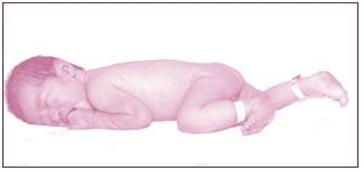
사진 2-1. 갓 태어난 신생아의 모습.
Copyright ⓒ 2012 John Sangwon Lee, MD., FAAP
| 출생 전기 분류 |
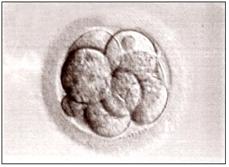
사진 2-2. 배자 테스트 튜브에서 수정된 수정란이 자라서 배자가 되고 배자가 자라서 태아가 된다.
Copyright ⓒ 2012 John Sangwon Lee, MD., FAAP
|
| 출생 전기 |
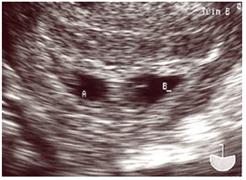
사진 2-3. 자궁 속에서 자라고 있는 쌍태아(A와B)의 초음파 사진
테스트 튜브에서 수정된 후, 인제는 엄마의 자궁 속에서 자라고 있다.
Copyright ⓒ 2012 John Sangwon Lee, MD/, FAAP
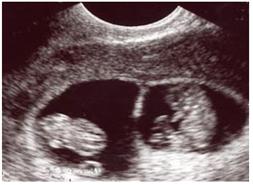
사진 2-4. 자궁 속에서 자라고 있는 쌍태아의 초음파 테스트 튜브에서 수정된 후. 이제는 엄마의 자궁 속에서 자라고 있다. 점점 더 자라고 있다.
Copyright ⓒ 2012 John Sangwon Lee, MD., FAAP

사진 2-5. 자궁 속에서 자라고 있는 임신 2개월 태아의 초음파. 테스트 튜브에서 수정된 후, 인이제는 엄마의 자궁 속에서 잘 자라고 있다.
Copyright ⓒ 2012 John Sangwon Lee, MD., FAAP

사진 2-6. 자궁 속에서 자라고 있는 임신 7개월 태아의 초음파. 테스트 튜브에서 수정된 후, 인이제는 엄마의 자궁 속에서 잘 자라고 있다.
Copyright ⓒ 2012 John Sangwon Lee, MD., FAAP
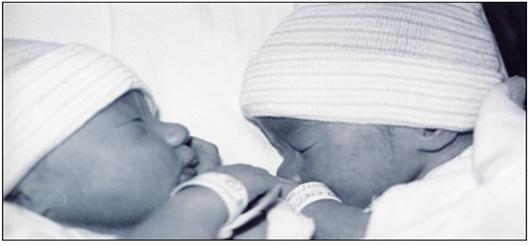
사진 2-7. 테스트 튜브에서 수정된 후 엄마의 자궁 속에서 자라다가 미숙 신생아로 태어난 쌍둥이.
Copyright ⓒ 2012 John Sangwon Lee, MD., FAAP
|
Growth development of newborn infants
See ‘Growth development of newborn infants’ above.
• There is a saying ‘Children are not miniature adults’.
• As this term implies, newborns, infants, toddlers, preschoolers, school-age children, and adolescents are collectively referred to as juveniles (0-18 years of age).
There are many uniquely different growth and development problems that cannot be seen in
• What makes it uniquely different?
• Newborns, in particular, are very different from post-natal infants, toddlers, school-age children, adolescents and adults. Newborns, infants, toddler infants, preschool children, school-age children, and adolescents are different from adults.
• It is markedly different from adults in that children and adolescents are constantly growing, developing (developed), and constantly changing each body system’s organ, mind, emotion, sociality, and cognitive ability.
• Children and adolescents who constantly grow and develop while raising children, it is sometimes difficult for parents and even pediatricians to know whether they are developing normally or abnormally.
• So, some parents worry a lot about the growth and development of newborns, infants, school-age children, and adolescents.
• There are many reasons to be so concerned, and most of them are very natural.
• For this reason, we intend to use this space, Volume 3 to provide information on the growth charts of children and adolescents.
• Children-Adolescents here refer to newborns, infants, toddlers, school-age children, and adolescents.
• Knowing more about the normal growth chart of children and adolescents according to age helps parents to raise their children properly.
• And it can make parenting and training more comfortable and easier for young children.
• Children and adolescents can grow up comfortably and happily.
What is growth?
• Growth and development ? These two words have the same meaning.
• Because the degree of growth and the degree of development are closely related to each other.
• Growth and development usually go in response to each other.
• For convenience, in the Department of Pediatrics, an increase in all or part of the body or an increase in the size of all or part of an organ is called growth.
• For example, the increase or decrease in weight can be measured in pounds or kilograms, and the increase or decrease in height can be measured in centimeters or inches, etc.
• Growth that can be measured in this way is called growth.
• The increase or decrease of the function of the whole body or a part of the body, or the complex concept of skill, can be called development.
• In other words, neuromotor proficiency, hands and feet, proficiency in part or all of the body, and degree of personality development belong to development.
• For reference, the two words development and development are used interchangeably.
• In other words, growth is the growth that can be determined by weighing and measuring height and determining whether it is large or small. The maturity level of the functions of each organ in the body can be called development.
• However, although the terms growth and development should be strictly and clearly used, it is often difficult to explain growth and development separately when describing the growth of children and adolescents as a whole.
• Most parents of pediatricians often need to consult a pediatrician because of their children’s growth and development and health problems.
• Here, parents are given an easy-to-understand explanation of the growth and development process and milestones of children and adolescents (newborns, infants, early toddlers (Toddlers), preschool children, school-age children, and adolescents).
• Although sperm and egg match, the period from the date of fertilization through 18 years to adulthood is divided into various growth and development stages as follows for convenience in pediatric science.

Picture 2-1. The appearance of a newborn baby. Copyright ⓒ 2012 John Sangwon Lee, MD., FAAP
Before Birth, classification

Photo 2-2. In an embryo in the test tube, a fertilized egg grows into the next stage embryo, and the embryo grows into a fetus. Copyright ⓒ 2012 John Sangwon Lee, MD., FAAP
• Prenatal period (出生前期): The period from the date the sperm meets the egg to the day of fertilization until birth is called the prenatal period. This period is about 280 days.
o Fertilized egg (受精卵): an egg fertilized by an egg and sperm
o Embryo (胚子): a baby in the womb that has grown and developed before 8 weeks of pregnancy
o Prenatal period (胎兒期): the period from the 8th week of pregnancy to the 42nd week of pregnancy
o Prematurity (未熟兒期): The period from the first 27 weeks of pregnancy to the 37th week of pregnancy Birth Biography

Photo 2-3. Ultrasound picture of twins (A and B) growing in the womb after being fertilized in a test tube, Twin is growing in the mother’s womb. Copyright ⓒ 2012 John Sangwon Lee, MD., FAAP

Photo 2-4. After fertilization in ultrasound test tubes of twins growing in the womb. Now it is growing in the mother’s womb. growing more and more. Copyright ⓒ 2012 John Sangwon Lee, MD., FAAP

Photo 2-5. Ultrasound of a 2-month pregnant fetus growing in the womb. After being fertilized in a test tube, the twin is growing well in the mother’s womb. Copyright ⓒ 2012 John Sangwon Lee, MD., FAAP

Photo 2-6. Ultrasound of a 7-month pregnant fetus growing in the womb. After being fertilized in a test tube, the twin is growing well in the mother’s womb. Copyright ⓒ 2012 John Sangwon Lee, MD., FAAP

Photo 2-7. Twins are born prematurely after being fertilized in a test tube, growing in their mother’s womb. Copyright ⓒ 2012 John Sangwon Lee, MD., FAAP
Classification after birth
• Neonatal period (新生兒期): the period from the day of birth to the first 4 weeks of life
• Infancy (嬰兒期): The period from 5 weeks to 1 year old. This period is also called infancy (乳兒期).
• Early childhood (幼兒期) = early infancy + preschool infancy
• Early infancy (初期 幼兒期/Toddler’s infancy): the toddler’s infancy from 1 to 3 years of age
• Early childhood period before school age: the infancy period from 3 to 6 years old
• School age: the period between the ages of 6 and 12.
• Puberty (思春期): The period from 8 to 10 years old to 18 years old for girls and from 9 to 12 years old to 20 years old for boys
• Children and adolescents (小兒靑少年): children aged 0 to 18 years old or from 0 to 18 to 21 years old
출처 및 참조문헌
- www.drleepediatrics.com 제1권 소아청소년 응급 의료
- www.drleepediatrics.com 제2권 소아청소년 예방
- www.drleepediatrics.com 제3권 소아청소년 성장 발육 육아
- www.drleepediatrics.com 제4권 모유,모유수유, 이유
- www.drleepediatrics.com 제5권 인공영양, 우유, 이유식, 비타민, 미네랄, 단백질, 탄수화물, 지방
- www.drleepediatrics.com 제6권 신생아 성장 발육 육아 질병
- www.drleepediatrics.com제7권 소아청소년 감염병
- www.drleepediatrics.com제8권 소아청소년 호흡기 질환
- www.drleepediatrics.com제9권 소아청소년 소화기 질환
- www.drleepediatrics.com제10권. 소아청소년 신장 비뇨 생식기 질환
- www.drleepediatrics.com제11권. 소아청소년 심장 혈관계 질환
- www.drleepediatrics.com제12권. 소아청소년 신경 정신 질환, 행동 수면 문제
- www.drleepediatrics.com제13권. 소아청소년 혈액, 림프, 종양 질환
- www.drleepediatrics.com제14권. 소아청소년 내분비, 유전, 염색체, 대사, 희귀병
- www.drleepediatrics.com제15권. 소아청소년 알레르기, 자가 면역질환
- www.drleepediatrics.com제16권. 소아청소년 정형외과 질환
- www.drleepediatrics.com제17권. 소아청소년 피부 질환
- www.drleepediatrics.com제18권. 소아청소년 이비인후(귀 코 인두 후두) 질환
- www.drleepediatrics.com제19권. 소아청소년 안과 (눈)질환
- www.drleepediatrics.com 제20권 소아청소년 이 (치아)질환
- www.drleepediatrics.com 제21권 소아청소년 가정 학교 간호
- www.drleepediatrics.com 제22권 아들 딸 이렇게 사랑해 키우세요
- www.drleepediatrics.com 제23권 사춘기 아이들의 성장 발육 질병
- www.drleepediatrics.com 제24권 소아청소년 성교육
- www.drleepediatrics.com 제25권 임신, 분만, 출산, 신생아 돌보기
- Red book 29th-31st edition 2021
- Nelson Text Book of Pediatrics 19th- 21st Edition
- The Johns Hopkins Hospital, The Harriet Lane Handbook, 22nd edition
- 응급환자관리 정담미디어
-
소아가정간호백과–부모도 반의사가 되어야 한다, 이상원
-
Neonatal Resuscitation American heart Association
-
Neonatology Jeffrey J.Pomerance, C. Joan Richardson
-
Pediatric Resuscitation Pediatric Clinics of North America, Stephen M. Schexnayder, M.D.
-
Pediatric Critical Care, Pediatric Clinics of North America, James P. Orlowski, M.D.
-
Preparation for Birth. Beverly Savage and Dianna Smith
-
Infectious disease of children, Saul Krugman, Samuel L Katz, Ann A. Gershon, Catherine Wilfert
- 소아과학 대한교과서
- Other
Copyright ⓒ 2015 John Sangwon Lee, MD., FAAP
“부모도 반의사가 되어야 한다”-내용은 여러분들의 의사로부터 얻은 정보와 진료를 대신할 수 없습니다.
“The information contained in this publication should not be used as a substitute for the medical care and advice of your doctor. There may be variations in treatment that your doctor may recommend based on individual facts and circumstances. “Parental education is the best medicine.”